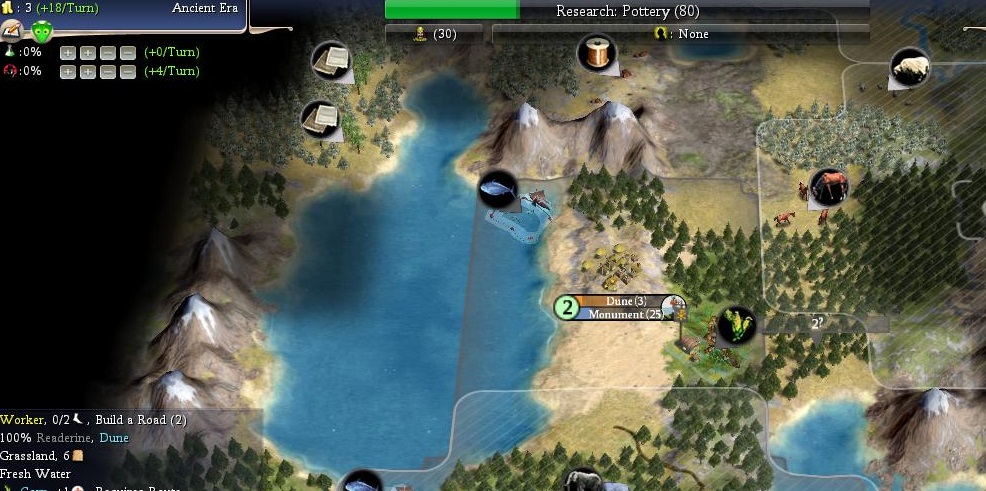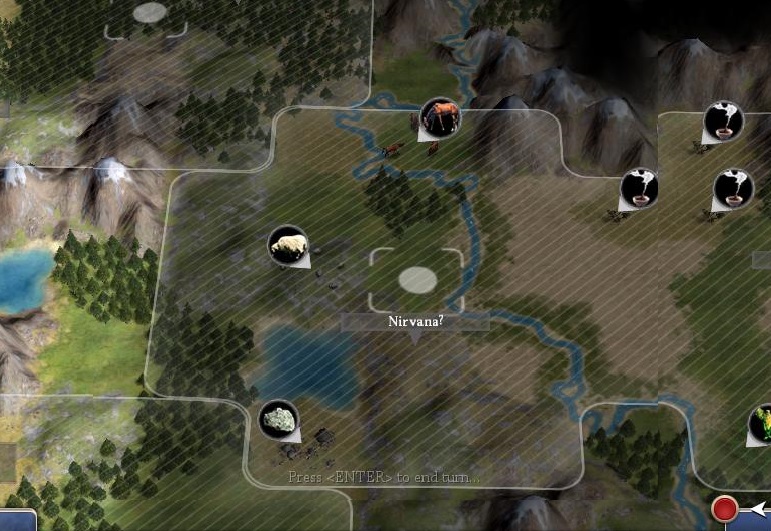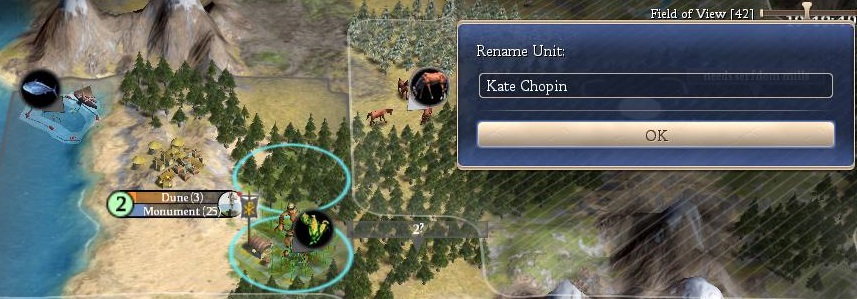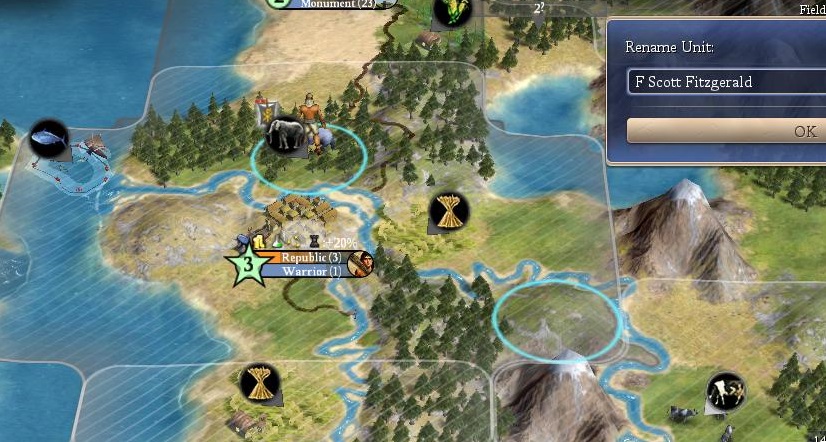Posts: 2,062
Threads: 20
Joined: Dec 2014
Civstats shows that everyone else just continues to grow in score, higher pop and more tech, no whipping. For as much as I want to trust in the CY, I can't help but wondering if I'm the one misplaying the start. It seems like if other people are growing their cities, they have to grow them onto mainly unimproved forests, but is that better than my size 2 and 3 menagerie?
Posts: 2,062
Threads: 20
Joined: Dec 2014
Aetryn joins the whipping club, as I continue to spam the thread.
AH is in. Dune finished our second worker, capital will finish a third in two more turns. Need to think about how to get the next few settlers out. Should start focus on chopping granaries. There are two horses nearby:

This makes getting a monument in Dune a priority, so it can have three good tiles to work. Since getting a settler out of this city seems unrealistic without chopping a bunch, and the workers would be better positioned southeast to start cottaging, I think the way to go here is to 1 pop whip the monument at size three and overflow into another worker.
Is it too much to ask for feedback since this is a greens game? When do people typically whip monuments? Or is it more common to chop them? I don't have the hang of this myself. The only game where I had a strong position was one where I built Stonehenge early.

The other horse is near the floodplains area. Nice to have as a backup.

Finally, to continue with the naming scheme, the second worker is named after Kate Chopin. The first female author to appear on this list, Kate Chopin rarely comes up outside of discussions of American literature. Like Hawthorne, I find her works unpleasant to read, but for rather different reasons. Hawthorne has regrettable prose and a void where interesting ideas should be. Kate Chopin has good prose - not great, but good, and ideas that shine bright as day. But they still seem rather unpleasant to me.
Most, if not all, of Chopin's stories have a very clear message. They feature very similar protagonists: married women past their twenties who feel there should be more to life than is on offer. This was a common sentiment in much proto-feminist literature of the time. Chopin goes a step further in saying exactly what is missing from these women's lives. Fun, in the form of parties, travelling, and casual sex.
The Awakening, Chopin's most famous novel, is a story about a married woman and mother of two who is bored. Despite having plenty of leisure time available to read and play the piano and chat with friends, she finds her husband and his habit of being away on business boring, she finds her own children boring despite not having to spend any time taking care of them herself, she finds the place she lives in boring. While her husband is away, she takes advantage of his absence to run around town on her own, falling in love with some local man, paying even less attention to her children then before, and living outside of her mansion and away from her servants. When she finds out that her husband is to return, she becomes so overcome with despair at the thought of not being able to continue this life that she just kills herself.
Another short story features a newly made widow, who becomes so overcome with delight at her boring husband dying that she then dies herself of happiness.
When suffragist and then later feminist works and causes came about, few described the aspects of female liberation in such hedonistic terms. Female liberation was and is described as a way for women whose innate talent was spurned and ignored to be utilized, for women who are cruelly punished and used by men to be freed and allowed to live healthier, better lives. Not so much is it the case that liberation was supposed to be liberation from boredom and the cruel confines of monogamous marriage - although there definitely was some of that besides just Chopin. The frankness of Chopin's writing does seem interesting to me for that reason: it strips out the moralizing that typically is part of such messages, and makes the intent crystal clear. But the message itself is so unpleasant that I don't find myself tempted to read her works more than once.
Posts: 15,135
Threads: 111
Joined: Apr 2007
(July 6th, 2023, 13:31)greenline Wrote: Is it too much to ask for feedback since this is a greens game? When do people typically whip monuments? Or is it more common to chop them?
Try to complete the Monument roughly 10T before you need to be able to access the tile(s) you're trying to get via culture. 
The rule of thumb is to try to never whip a city before a Granary is built as that effectively doubles your food surplus. If you have no choice but to get a Monument before Granary, sometimes I'll chop it for exactly that reason because it lets me keep growing. However, if you HAVE to build a Monument right away in a city, sometimes it's worth going back and considering whether you could have placed your cities in a way to avoid this. I try not to whip Monuments just because it feels kind of bad to 1 pop whip, and it feels really bad pre-Granary. Sometimes I'll try to just 1T it with whip overflow, for example. Granaries on the other hand feel much better to whip because you get to fill the foodbox with less food at size 1 or 2 than at sizes 3 or 4, so you get that additional benefit.
I haven't followed your micro closely enough to know about your decisions, but that's my best stab at super general advice that may or may not apply here.
Posts: 2,062
Threads: 20
Joined: Dec 2014
(July 6th, 2023, 14:42)scooter Wrote: Try to complete the Monument roughly 10T before you need to be able to access the tile(s) you're trying to get via culture. 
The rule of thumb is to try to never whip a city before a Granary is built as that effectively doubles your food surplus. If you have no choice but to get a Monument before Granary, sometimes I'll chop it for exactly that reason because it lets me keep growing. However, if you HAVE to build a Monument right away in a city, sometimes it's worth going back and considering whether you could have placed your cities in a way to avoid this. I try not to whip Monuments just because it feels kind of bad to 1 pop whip, and it feels really bad pre-Granary. Sometimes I'll try to just 1T it with whip overflow, for example. Granaries on the other hand feel much better to whip because you get to fill the foodbox with less food at size 1 or 2 than at sizes 3 or 4, so you get that additional benefit.
I haven't followed your micro closely enough to know about your decisions, but that's my best stab at super general advice that may or may not apply here.
Thanks! That's a pretty useful trick to follow. I think I've been overvaluing 1 pop whips, just because my cities have only a few early food resources and no cottages yet. But pottery is only a few turns away, so it makes way more sense to go for the granary whips and then use the overflow on the monument, I think.
Posts: 15,135
Threads: 111
Joined: Apr 2007
I should clarify, I'm really talking about what's most efficient. There are times you just need the Monument asap, and it's unavoidable, so do what you've gotta do. I'd just say that careful city placement can sometimes keep you from getting into that situation, which then allows you to slot the Monument in when it's more convenient. But yes, 2-pop whips in general are going to be better than 1 pop whips. 2 pop + 1 unhappy for 60h is a better trade than 1 pop + 1 unhappy for 30h - it's half as much unhappiness relative to the amount of production/population, among other benefits.
Posts: 23,408
Threads: 132
Joined: Jun 2009
1 pop generally mean something has gone wrong somewhere, so I'd suggest looking at micro that doesn't rely on them. Exception to this is the granary whip.
Current games (All): RtR: PB80 Civ 6: PBEM23
Ended games (Selection): BTS games: PB1, PB3, PBEM2, PBEM4, PBEM5B, PBEM50. RB mod games: PB5, PB15, PB27, PB37, PB42, PB46, PB71. FFH games: PBEMVII, PBEMXII. Civ 6: PBEM22 Games ded lurked: PB18
Posts: 2,062
Threads: 20
Joined: Dec 2014

Worker number three from the capital is named after F. Scott Fitzgerald, another American writer known for a couple of shorter works written near the turn of the century. His works are highly regarded in America, ever since their inclusion in a government program for distributing novels to overseas troops. I can't help but feel that promotion was a big part in his later success.
Reading Gatsby and his other works, for me, felt like trying to draw blood from a stone. There is a trickle of meaning there, a trickle of intrigue, but what's there is thin and soft.
The Great Gatsby, his magnum opus, is the story of a man named Gatsby who is the center of the New York social scene in the midst of the 1920s. He's rich, he generously spends much of that wealth on lavish parties, and he's very much into a married woman named Daisy. Precisely why he desires Daisy so much is only stated later - Gatsby comes from a poor background, and to have Daisy would be to cement his position as having truly moved into the upper class. But things do not go his way, and Daisy decides to keep staying with her boorish aristocratic husband rather than this boorish noveau riche man, and this leads to a strange series of drunken events where Gatsby takes the fall for someone being hit with a car and is murdered.
So, I will try and squeeze some more blood from this stone again. Obviously, the book is telling me that the people who were involved in these 1920s flapper parties were really shallow assholes - something that should be self evident. Obviously, Gatsby was chasing some kind of 'tragic' dream he could never realize, because he was born as a shoe shiner. And yet...
What is there one can really take away from this? It's hard to see Gatsby as tragic because his own goals are shallow. He wants an upper class wife to validate his desire to be seen as rich. He's really as much a pest as anyone else in the book. There are other books that describe the New York City social scene as being full of pests in far less words. What else can be taken from the characters and the scenarios?
Some people will say that the intent was just to show the general pest-iness of the roaring twenties, but I think that was not the intent. While I do not generally like to employ death-of-the-author tricks, in this case, I think it's necessary. F. Scott Fitzgerald as a man resembles the character Gatsby in several ways. He was also an outsider to the New York City social life, and he even had a Daisy of his own that he propositioned as a young man and who rejected him. Later in life, that same woman was told about the character in the book who seemed to resemble her, which she laughed at.
There's too much positive imagery and nice sounding words in the book said about Gatsby to make me think it was a coincidence. There's too many similarities with the author's life to make me think it was done in a mocking or insincere way. It can't help but feel like Fitzgerald was pouring his own life's frustrations into this character, making his own problems the focus of the story, his own quest for a high class woman and fitting in at the country club a tragedy. And that, at least to me, can't help but make the whole book seem like a pest. I have no sympathy for the man's problems.
I welcome anyone who can show me that I'm wrong, and that there really is something about this book I've been missing this whole time.
Posts: 2,062
Threads: 20
Joined: Dec 2014
For the micro details, we have three workers now. One is finishing the pigs in Creation and then will mine the copper. The other two will camp the ivory, then chop a granary at the capital. That will leave it in a good position to whip or chop the next settler, and clear the forests to start laying down cottages on the river. I'm worried that I'm taking too long to get the next settlers out, but it is tricky without IMP's 2 pop whips. I am hoping being able to get granaries going in all our cities will make up for that.
Posts: 4,572
Threads: 31
Joined: Nov 2016
Been some busy days, but finally logged in for a look around.

One thing that strikes me is the lack of lux. So far we only have the starting ivory and three calendar lux far away from the capital; the spices are probably outside our reach. Makes it very important to get the most out of every whip. I like the warrior poking south from Creation, what it sees could change what I say next:
Next few cities, in order should probably be:
Animal Farm is probably our next city; green land and strong tiles on the way to..
Nirvana is moved back to the plainshill; This will be a very nice city down the road.
Incensetuous could probably go south on the desert hill, but that negates a filler between this and..
Needs seafood could go NW-NW if there's no seafood available; this is likely to be our border fortress towards Bing. Anything we can claim south of this is a bonus.
Other notable sites:
Chainmail hopefully has some food in the fog; if nothing else it has a lighthouse lake.
Equinox I and II are both decent cities that will take ages to mature due to lack of food.
Plains cotttage hell is likely to be a northern border fortress
One thing I've not done earlier is note the map dimensions: There are 1365 tiles, a fair amount of which we can assume are peaks, and playing with the warrior reveals the map is 52 wide and 28 tall. Note that we're almost in the middle while Bing is only a few tiles from the southern edge. All of this makes me wonder if the starts are paired of in duels with a pretty large wilderness, or if all four are pretty close and it's an even larger wilderness.
Looked over the cities as well; Republic might have been better off working the lake over the ivory to push Pottery in a turn earlier.
(July 6th, 2023, 13:31)greenline Wrote: Is it too much to ask for feedback since this is a greens game? When do people typically whip monuments? Or is it more common to chop them? I don't have the hang of this myself. The only game where I had a strong position was one where I built Stonehenge early.
I try to either chop one out as soon as the city is founded, or whip with the first pop if it's really urgent, or settle the city so that the culture isn't needed early. With our happy situation I'd rather 2-whip something (like a 4h axe) and dump the overflow into the monument or granary.
Posts: 2,062
Threads: 20
Joined: Dec 2014
Good call on the lake tale for Republic. Mistake on my end for not recognizing that it would get to pottery sooner. Unfortunately not much can be done now - I played around with tile configs and there's no way to get pottery in one turn.
The lack of luxuries makes me think that Monarchy would be a good tech path to consider after Pottery. I'm not sure if this is the best kind of land for serfdom, but I'm leaning that way with the number of slower growing cities.
Another option would be going for sailing and pushing for the land across the sea to the west. Do you think that would be worth it? Based on the latitude, it would probably be as green as the land directly to the east, rather than the tundra to the north or desert to the south. It would be harder to defend, of course, and take more hammer investment for the ships.
I was planning to start working on some Axe + Spear pairs out of Creation - the city doesn't need culture for a while, and it will get a lot of innate production for the copper. But most of the early military would be in creation, as it will take a while to settle all the way to the east coast.
Another option is making a play for an early wonder with the stone. But most cities don't have a lot of easy forests to chop. Dune has the most, but it would be awkward for now to have all the workers moved in that direction.
|




